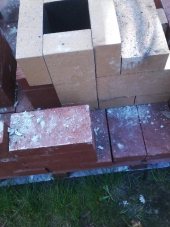








Rocket Mag evolution timeline: http://www.permies.com/t/52316/rocket-stoves/Rocket-stove-heats-water-pics
Rocket Mag Thread: http://www.permies.com/t/54074/rocket-stoves/Rocket-Mag-heater-Rocket-Mag




positively optimistic 🙂 https://www.youtube.com/@613Builds




Success has a Thousand Fathers , Failure is an Orphan
LOOK AT THE " SIMILAR THREADS " BELOW !





God of procrastination https://www.youtube.com/watch?v=q1EoT9sedqY




 The chimney will go a good metre taller than the apex of my roof, but would you advocate the traditional witches hat, a h cowl (what should I call it here!?), or one of those spinning domes?
The chimney will go a good metre taller than the apex of my roof, but would you advocate the traditional witches hat, a h cowl (what should I call it here!?), or one of those spinning domes?









Glenn Herbert wrote:The common advice from experts is that a 6" RMH can handle about 35' of duct, minus 5' for every 90 degree elbow. A really good chimney can maybe increase this a bit.






The common advice from experts is that a 6" RMH can handle about 35' of duct, minus 5' for every 90 degree elbow. A really good chimney can maybe increase this a bit.
"Never doubt that a small group of thoughtful, committed citizens can change the world; indeed, it's the only thing that ever has."-Margaret Mead "The only thing worse than being blind, is having sight but no vision."-Helen Keller




Rocket Mag evolution timeline: http://www.permies.com/t/52316/rocket-stoves/Rocket-stove-heats-water-pics
Rocket Mag Thread: http://www.permies.com/t/54074/rocket-stoves/Rocket-Mag-heater-Rocket-Mag














Rocket Mag evolution timeline: http://www.permies.com/t/52316/rocket-stoves/Rocket-stove-heats-water-pics
Rocket Mag Thread: http://www.permies.com/t/54074/rocket-stoves/Rocket-Mag-heater-Rocket-Mag










Success has a Thousand Fathers , Failure is an Orphan
LOOK AT THE " SIMILAR THREADS " BELOW !






